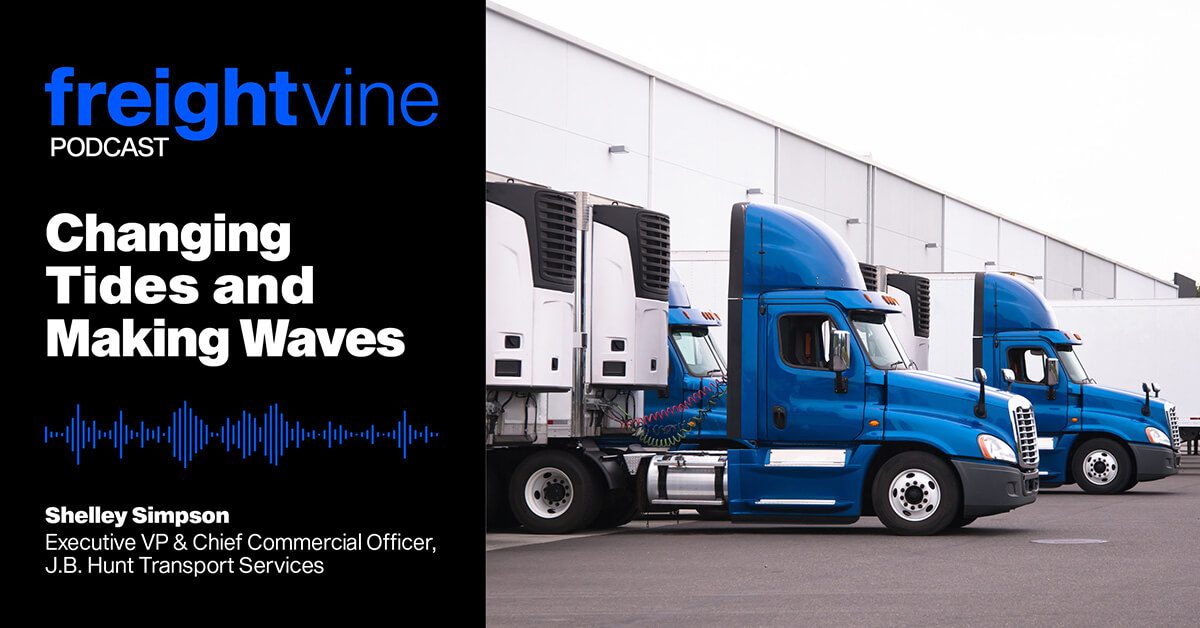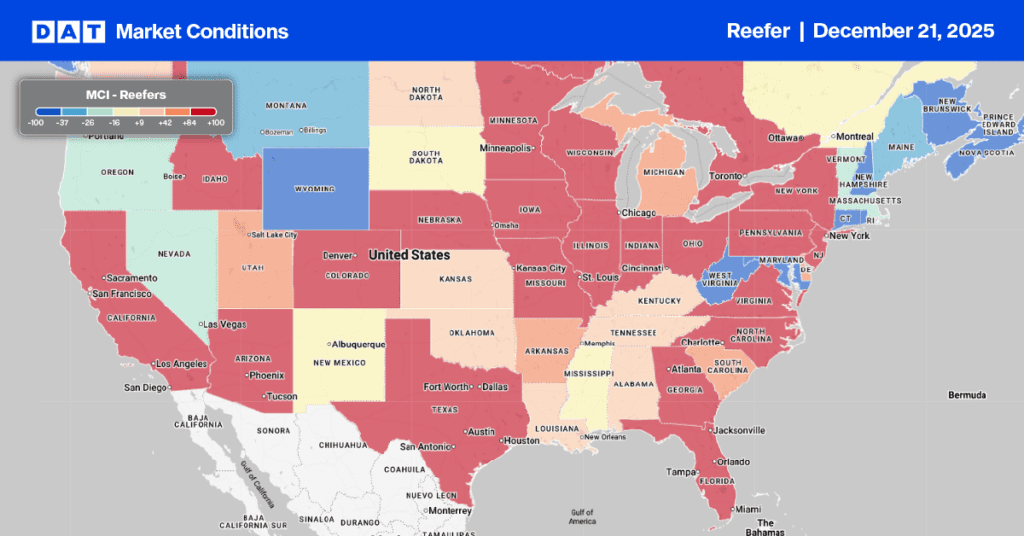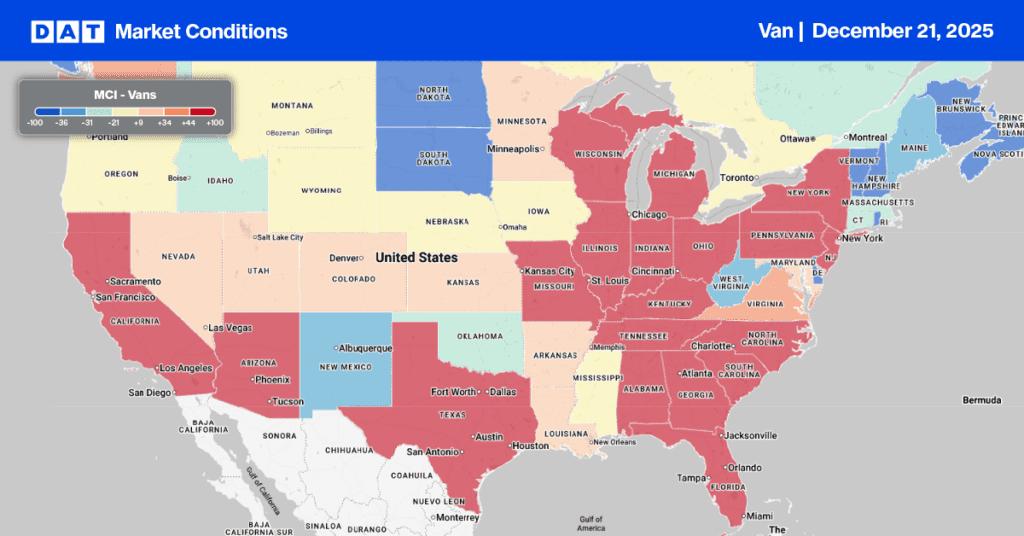J.B. Hunt’s Shelley Simpson discusses the company’s journey from carrier to asset-based brokerage — along with its development of the multi-modal digital freight platform, J.B. Hunt 360.
As the trucking industry moves increasingly toward digital technology, carriers and shippers are looking for convenient, on-the-go solutions to find and move freight. In response, transportation logistics company J.B. Hunt launched the J.B. Hunt 360 platform to help carriers and shippers across the country connect and get loads delivered on time.
In DAT’s recent podcast episode, host Chris Caplice spoke with J.B. Hunt’s Chief Commercial Officer and EVP of People and HR, Shelley Simpson. They discuss how the company has become a leader in digital innovation over the past 25 years, culminating in the launch of J.B. Hunt 360. During this time, J.B. Hunt has grown to include nearly 20,000 drivers and $10 billion in annual revenue — growth that is in large part due to the company’s ambitious adoption of new technologies.

Setting the Foundation for Success
When Simpson started at J.B. Hunt over 25 years ago, she was fresh out of college and the company had just celebrated reaching $1 billion in revenue. Today, J.B. Hunt is nearing $10 billion in revenue, almost all of which is due to organic growth.
Simpson says that after two and a half decades, the company’s personal touch and support for drivers remains a constant. Yet J. B. Hunt has modified its approach from a product-based sales organization to a consultative solution-based organization. In the process, the company has rapidly grown its technology offerings, including the J.B. Hunt 360 platform.
Creating a freight brokerage inside an asset-based company was a bold and, in many ways, unprecedented move, but it helped J.B. Hunt address new challenges for customers. In particular, the company began to look at how truck drivers could spend their time more efficiently. J.B. Hunt examined what drivers were doing in the 11 hours each day that they were on the road and found that the most promising opportunities for owner operators to eliminate empty miles was through technology.
Building J.B. Hunt 360
After identifying ways to reduce waste, J.B. Hunt embarked on a mission to build a platform that could increase driver efficiency. From there, the company developed its multi-modal digital freight broker technology for shippers and carriers called J.B Hunt 360.
J.B. Hunt attracted nearly 800,000 trucks on its real-time platform through the app, J.B. Hunt Carrier 360, — and is working on bringing in more shippers.
The platform segments customers based on their needs, so J.B. Hunt has micro shipper, small shipper, medium shipper, and large customer strategies. As Simpson says, “You have to be able to have the right number and level of shipments and the right number and level of carriers to make the right match.”
Working Toward Innovation
When it comes to supply chain innovation, J.B. Hunt’s decision makers base their approach on core questions like “How do we disrupt our way of thinking, and how do we disrupt ourselves?” Disruption has been a prominent theme for the company — particularly the idea that disruption is good for business if J.B. Hunt is leading the charge.
In 2015, J.B. Hunt implemented a project called Elevation that was based around the values of inclusion and innovation. This project was an internal process that allowed anyone in the company to submit an idea on how to grow revenue, reduce costs, or just make J.B. Hunt a better place to work. So far, the staff of 30,000 people has submitted over 20,000 ideas.
The Elevation team is responsible for reviewing these submissions, and then finding sponsors in the business to vet the best ideas. Then the ideas that get approved go to the executive team for review. This process has facilitated innovation inside the organization, and embracing new technology has pushed J.B. Hunt to better serve customers.
For instance, for J.B Hunt’s DRIVE app, drivers sent in a variety of updates and suggestions. These suggestions have prompted the company to implement an electronic bill of lading, which is a way to protect and create a level of safety for drivers and customers. The idea was quickly approved and moved rapidly into production.
Adapting and Modifying for Success
In J.B. Hunt’s cycle of innovation, the company has moved from “disrupt” to “adapt”. The adapt phase describes the process of each person adapting individually to change and helping customers adapt to new technologies. The third phase of the cycle is called acceleration, which promises a rapid roll-out of new solutions.
Before launching J.B. Hunt 360, the company held an advisory forum with customers from different segments. Different types of customers attended three different forums with the executive team, giving customers a chance to share their perspective. These customers got a sneak peek into the services the company was considering for the 360 J.B. Hunt load board, and were able to voice their opinions on how these services could be developed and rolled out.
These customer forums were the first to preview J.B. Hunt 360 in August of 2016, far in advance of the April 2017 launch. These forums helped the company validate its roadmap, and determine which features the product would have. The number one piece of feedback from customers was to incorporate drop trailers. This idea led to the launch of 360box, which gives small carriers looking for loads using the app to access to drop and hook freight.
Recently, J.B. Hunt has expanded into Final Mile. In the past, the company had been providing Final Mile services for a couple of key customers, but it wasn’t a feature that was actively promoted.
After discovering that customers were looking for a trustworthy national provider, J.B. Hunt officially went into Final Mile. Then in the last three to four years, the company moved toward blending in non-asset-based services and working with contractors along with its asset fleet in Final Mile. This enabled J.B. Hunt to personalize customer service based on individual needs.
J.B. Hunt’s Final Mile includes some business to business services, but it is primarily focused on business to consumer offerings. The company has found that people need someone to cross the threshold, and therefore provides thorough background checks, making sure that there is proper training on how to actually enter a home. Ultimately, J.B. Hunt is gathering info to evaluate what the end customer thinks of the experience.
Adjusting to the New Normal
When the COVID-19 crisis hit, J.B. Hunt’s leaders started to consider whether or not certain employees should be working from home. Yet the company’s leadership recognized that all of the maintenance technicians, professional drivers, and operating teams are essential workers, and there’s not a work-from-home option for those jobs.
Today, J.B. Hunt recognizes that technology is key to succeeding in a post-COIVD-19 world for both carriers and shippers. The lockdown and following restrictions accelerated innovation and adoption of new technologies across the industry, instigating change in an unprecedented way. This has made J.B. Hunt 360 for carriers and shippers a particularly important tool to connect as they look toward 2021.


